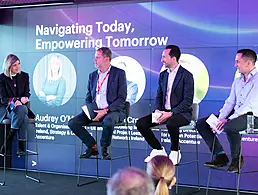HRLocker’s Crystel Robbins Rynne gives a step-by-step approach to ensuring employee buy-in when it comes to adopting AI in the workplace.
There’s a lot of buzz around the power of artificial intelligence (AI) to transform organisations. Forbes, for instance, reports how it improves productivity by automating routine or repetitive tasks and augments human skills by streamlining workflows, freeing up time and effort for more business-critical outputs.
Reports such as these leave little doubt about the value of AI as a strategic investment for businesses. Still, given that a recent Government report categorises 63pc of employment in Ireland as relatively highly exposed to AI, it’s essential to explore how AI impacts those using it day to day in their professional lives.
Understanding the AI-employee trust gap
Our latest employee survey asked workers across the Republic what they think about AI in their workplace. Of the 500 respondents, only half trust AI. The root of this unease is complex and varied. However, careful analysis reveals some common themes.
Poor communication from leaders
Three in five workers feel there isn’t enough guidance from management about how AI will be used and its impact on them. It means employees are left with many uncertainties, which is a source of anxiety.
A lack of transparency
Two-thirds of employees are uncomfortable with HR processes using AI, fearing potential bias and a lack of transparency. One worry is that AI decision-making is done in a black box, making it difficult to understand and challenge.
Worries about data privacy
The impact of AI on the confidentiality of personal information is a source of misgiving for 44pc of workers. AI systems often require access to sensitive data, and workers are understandably questioning who has access to it and if it’s securely stored.
Apprehension about governance issues
More than 70pc of employees feel their organisations aren’t collaborating on AI regulation, and 78pc indicate a lack of shared guidelines on responsible AI use, feeding fears of regulatory repercussions.
Anxiety over unfair treatment
Almost half of employees worry that AI could lead to unfair treatment in performance evaluations. Without clear explanations, employees are anxious about being judged by impersonal algorithms rather than human managers.
Fears about job security
Nearly a third of employees are concerned that AI could lead to job displacement. AI’s ability to automate tasks raises the issue of making some roles traditionally filled by people obsolete.
Overall, these findings suggest room for improvement in how employees are managed during AI implementations. It’s a conclusion reinforced by the 2024 Chartered Institute of Personnel and Development (CIPD) HR Practices in Ireland Report, which found a drop in the proportion of respondents who felt people leaders are advocating for employees when it comes to technology.
In fact, mirroring our findings, a little over half (53pc) said their employers champion a people-centred approach compared with more than three-quarters (77pc) in 2023 – meaning there’s work to be done.
Working to close trust gap
There’s no one-size-fits-all, quick fix to get workers to trust AI. It takes a consistent and tailored approach. The approach will vary depending on the organisation’s unique characteristics including size, number of employees and level of AI adoption. Still, having worked with and guided companies through tech-driven transformations, we advocate an approach that includes certain principles and follows best practices.
Communicate and collaborate
One of the ways to bridge the trust gap is by prioritising open dialogues. In practice, this involves providing regular updates about AI initiatives, talking about the implications before introduction and gathering feedback once it’s in place.
For communication to be effective, it must be two-way. Seeking and valuing employee feedback demonstrates you’re not just listening, but rather, you’re actively engaging in a meaningful dialogue. This approach fosters a sense of joint ownership and collaboration, making employees feel like an integral part of the AI journey.
Educate employees
Employees can feel lost if new technologies are introduced with little education or training. As emphasised in the above CIPD report, not all personnel need to become AI experts. However, users must be taught to understand the technology, how to use it effectively and how it actually helps them.
As business leaders, we are responsible for expanding understanding at all levels. That way, our employees will feel like they’re embarking on a journey with us instead of being dropped off in an unknown location without a map.
Implement transparent governance
Business leaders have an essential role in setting out rules and guidelines for using AI. Such rules must be clearly laid out and communicated to the whole workforce.
When employees know what is and isn’t expected of them and see it applied across the board, it cuts down confusion, boosts confidence and helps them realise their part in the grand scheme of things, strengthening their sense of purpose.
Foreground benefits
It’s also important to present AI implementation as a way of solving specific problems rather than another tech roll-out that changes workflows and processes that don’t need changing.
Taking a problem-focused approach also foregrounds the benefits of AI for performance. Outlining the successes seen in other departments or similar organisations as proof points further helps with buy-in and getting employees on board with changes, turning potential adversaries into advocates.
A human-centred approach to AI
As AI continues to reshape the workplace, business leaders have a vital responsibility to nurture positive relationships between employees and the AI tools they implement. Prioritising clear communication, comprehensive education, transparent governance and effective outcomes will help employees feel more comfortable and confident with AI.
The successful integration of workplace AI depends not just on technology but on people. By taking a thoughtful, human-centred approach, we ensure that AI enhances the employee experience, supports organisational goals, and creates a more trusting and collaborative work environment for all.
Crystel Robbins Rynne has worked with HRLocker since its inception. As chief operating officer, she is responsible for maintaining and driving operational results. She is part of the executive management team, an employee experience advocate and host of the popular HRLocker podcast.
Don’t miss out on the knowledge you need to succeed. Sign up for the Daily Brief, Silicon Republic’s digest of need-to-know sci-tech news.




